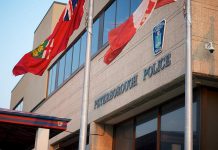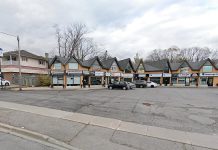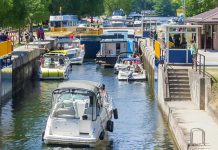
In 2018 the provincial voice for cycling, Share the Road, released an infographic titled Bikes Can Do That! It details seven benefits that can be achieved when bikes become the daily vehicle of choice for more people in your community. Over the next year, we plan to dive into each of these ideas through a #BikesCanDoThat series via our GreenUP column. To begin today, we tackle how bikes can reduce traffic congestion and get our city moving.
Traffic congestion is a concern for many of us as we make our way through and around Peterborough. It can increase travel times, impact our feelings of safety at crossings, and contribute to polluting emissions.
Current projections suggest that traffic congestion will grow alongside our community’s population.
Common practice often recommends that we increase the number of vehicle lanes to accommodate population growth and alleviate congestion. However, it is now well known that increasing the number of lanes actually leads to increases in the numbers of vehicles, and that over time, congestion continues to be a costly concern.
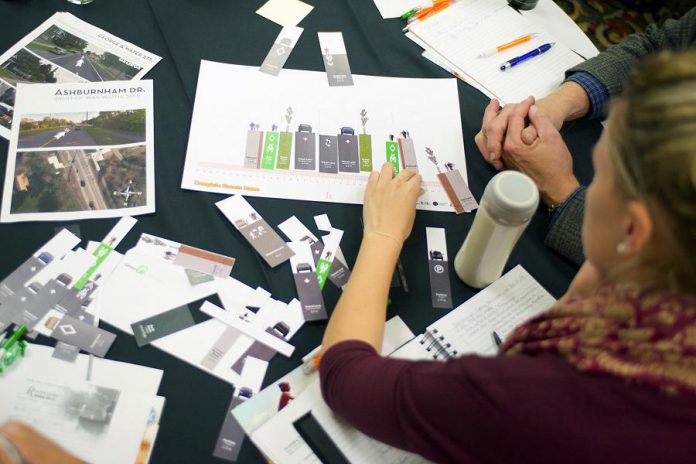
Continuing to increase the number of lanes on our city’s popular corridors is not a sustainable long-term solution to our congestion problem. Road development is restricted by the width of the road or right-of-way, and the neighbouring buildings. Alternatively, we need to examine how to use the available space to facilitate the movement of people in the most effective way possible.
Recently, you may have seen an image circulating on social media; it compares the amount of space needed to move a number of people by bike, with the same number of people by bus, and also by personal motor vehicle. These photos clearly show that cars require the most amount of space to move people.
To put it another way, the City of Vancouver has recently shared data revealing a similar trend; the number of people moving, per direction, in a given a three meter-wide lane, would total 700 to 1,000 if they are travelling by private motor vehicle, 2,000 to 3,000 by two-way protected bike lane, 2,000 to 4,000 if travelling by bus, and up to 5,000 to 6,000 by sidewalk.
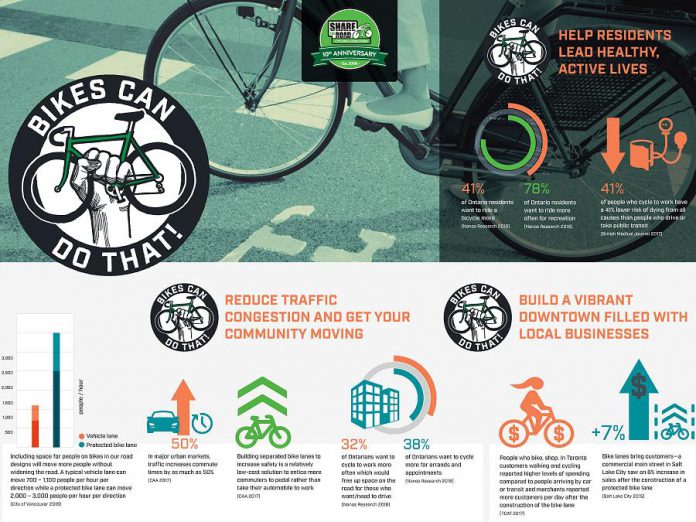
As active transportation choices like walking and biking gain attention and popularity, researchers are beginning to investigate the role these travel modes can play in reducing traffic congestion. Research is showing that measures taken to promote biking and walking have a positive effect on congestion. After all, one more bike beside you is one less car in front of you.
This shift doesn’t happen overnight, but evidence in Peterborough shows that investments in bike travel have strong potential to positively impact our transportation system. Geographically, Peterborough is fairly compact. Surveys show that we travel a median distance of 2.7 kilometres per trip on weekdays, and 73 per cent of all our trips made are less than 5km. In fact, 80 per cent of our community members live and work within the city.
And, we know that public interest exists for active modes. A survey completed by Nanos, an independent research firm, shows that last year, 32 per cent of Ontarians want to bike to work more often, and 38 per cent want to bike more often for errands and appointments. In Peterborough, rates of bike riding have shown substantial increases, from 0.7 per cent in 2006 to 3.5 per cent in 2016.
These increases have happened alongside investments in Peterborough’s bike network. The number of kilometres of bike lanes and trails has doubled in the last 10 years, reaching 71 kilometres in 2018.
200 people in cars, on bikes, on buses & light rail. Mobility in cities is about space. pic.twitter.com/37IGilVs3a via @adamjcs #Seattle
— Brent Toderian (@BrentToderian) July 29, 2015
The increases in bike riding and bike infrastructure seem to be correlated, especially when we learn that 77 per cent of respondents to the 2017 Peterborough Bicycle Advisory Survey indicate that they prefer routes with dedicated cycling infrastructure (i.e. bike lanes or multi-use trails), and that number increased to 89 per cent when respondents were questioned about preferences on busy roads.
In the book How Cycling Can Save The World, author Peter Walker points out, “Traffic infrastructure has huge capacity to shape the way people move about and live. Where ever there are people on the move, much of the way they move is shaped by the planned environment for different types of transportation.”
This time of year, it is interesting and exciting to see what plans are being made for bike infrastructure in the year ahead, as Peterborough City Council sits down this week to debate and set the budget, and along with it, a work plan, for 2019.
A quick scan through the budget documents shows that this year will bring the redevelopment of some important corridors, like Parkhill Road West, Chemong Road, Sherbrooke Street, and Lansdowne Street. Charlotte Street, the Crawford Trail Extension to Bethune Street, and the Otonabee Rail Trail have been moved from this year’s budget, but will soon follow in 2020.
In 2019, work will also continue on the City’s Official Plan Review, Transit Review, and a new Trent Severn Waterway/City Transportation Study. Each of these will offer opportunities to shape the way people will move around, and live in Peterborough.
With so much planned for 2019, keep an eye open for public consultations for these upcoming projects and plan reviews. The consultations will provide you with the chance to help shape our future transportation system into one that efficiently moves people by harnessing the potential found in active transportation.
Throughout 2019, GreenUP will be exploring the benefits that can be achieved by a city and its residents, when it commits to valuing the bike as a significant, useful, (and fun) mode of transportation, through the #BikesCanDoThat series.
If you’d like to contribute to the #BikesCanDoThat series, please contact Lindsay Stroud, Manager of Transportation and Urban Design Programs at GreenUP, at 705-745-3238 or lindsay.stroud@greenup.on.ca.



